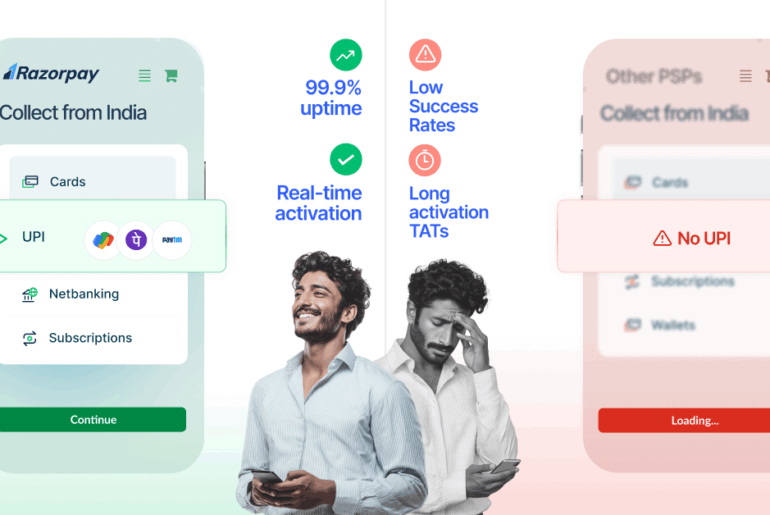Table of Contents
What is Merchant Discount Rate (MDR)?
The Merchant Discount Rate (MDR) is a fee charged by payment processing companies to merchant companies for each credit or debit card transaction made by customers. This fee typically ranges from 1% to 3% of the transaction amount.
The MDR fees cover a variety of costs, including:
- Payment processor fee: These fees are charged by payment processors (companies that handle transactions between merchants and banks like Razorpay) for their services.
- Interchange fee: These are fees charged by card issuers (banks) to merchants for processing transactions.
- Assessment fee: These are fees charged by card networks (like Visa, RuPay and Mastercard) to merchants for using their payment processing services.
- Markup fee: These are fees that is divided among the different entities involved in the transaction
- Additional fees: Some payment processors may charge additional fees for services like fraud prevention, chargeback handling, and customer support.
Related Read: What is POS System and How it Works?
What is the Purpose of Merchant Discount Rate (MDR) in Banking?
The MDR serves multiple purposes within the payment ecosystem:
1. Covering Payment Processing Costs
The MDR structure is designed to cover various costs associated with payment processing, including:
- Interchange fees charged by card issuers
- Network fees imposed by card networks
- International transaction fees for cross-border payments processed through an international payment gateway.
2. Incentivizing Card Usage:
- By establishing clear fees, the MDR makes it more attractive for merchants to accept card payments. This increased acceptance benefits consumers by offering a wider range of payment options.
- It also leads to higher sales volumes and improved cash flow management for businesses.
3. Managing Risk
- The MDR includes fees that help mitigate payment risks, such as chargebacks and fraud.
- This allows merchants to set aside funds for dispute resolution and fraud prevention measures.
4. Rewarding Cardholders
- A portion of the MDR is used to fund cardholder rewards and benefits programs.
- This incentivizes card usage and fosters customer loyalty by offering perks like cashback, points, and other benefits.
5. Supporting Payment Infrastructure
- The MDR contributes to the development and improvement of payment technologies, enhancing security and user experience.
- By funding these advancements, the MDR helps create a more efficient and robust payment ecosystem.
6. Driving E-commerce Growth:
- The MDR supports the integration of various payment methods, making it more convenient for online shoppers.
- This helps drive the growth of e-commerce and digital payments.
How does the Merchant Discount Rate (MDR) Work in Banking?
Here’s a breakdown of how the MDR works:
STEP 1: Customer Makes a Purchase
A customer uses their credit or debit card to make a purchase at a merchant’s store.
STEP 2: Transaction is Processed by Payment Processor
The merchant’s POS terminal sends the transaction details to the payment processor or payment gateway.
STEP 3: Authorization Request to Card Issuer
The payment processor or top payment gateway in india like Razorpay sends an authorization request to the card issuer.
STEP 4: Authorization Granted or Denied by Card Issuer
The card issuer verifies the customer’s account balance and credit limit. If approved, the authorization is granted. If denied, the transaction is declined.
STEP 5: Payment Settlement
If the transaction is authorized, the payment processor settles the transaction with the card issuer. The card issuer then credits the merchant’s account for the transaction amount, minus the interchange fee and any other applicable fees.
STEP 6: Merchant pays MDR
The merchant pays the MDR to the payment processor. The MDR covers the costs associated with processing the transaction, including the interchange fee, assessment fees, processing fees, network access fees, and any additional fees.
It’s important to note that the MDR can vary depending on factors such as the type of card used (credit or debit), the card network, the merchant’s industry, and the transaction amount. Merchants may also be able to negotiate lower MDR rates with their payment processors.
Merchant Discount Rate (MDR) Charges in India for 2025
Here’s the list of payment methods along with the card network and their MDR charges
Payment Method |
Card Network |
MDR Percentage on Credit Card |
MDR Percentage on Debit Card |
| Card Payments | Visa | 1% to 3% | 0.25% to 1% |
| Card Payments | Mastercard | 1% to 3% | 0.25% to 1% |
| Card Payments | RuPay | 1% to 3% | 0.25% to 1% |
| UPI Payments | UPI | 0.25% to 0.75% | 0.25% to 0.75% |
| Net banking | Various banks | 0% to 0.25% | 0% to 0.25% |
| Mobile Wallets | Various providers | 0% to 1% | 0% to 1% |
Related Read: POS Machine Charges and Transaction Fees
How to Calculate Merchant Discount Rate (MDR)?
To calculate the MDR for a transaction, you’ll need the following information:
- Transaction Amount: The total amount of the purchase, including taxes and fees.
- MDR Percentage: The percentage rate charged by your payment processor for the transaction. This can vary based on factors like card type, transaction value, and merchant category.
Formula to Calculate Merchant Discount Rate (MDR)
MDR Amount = Transaction Amount * MDR Percentage
Example of MDR Calculation
If you have a transaction of ₹5,000 and your payment processor charges an MDR of 2%, the calculation would be:
MDR Amount = ₹5,000 * 2% = ₹100
Therefore, the MDR for the transaction would be ₹100.
Note: This percentage rate depends on several factors like transaction amount, payment type and processing method.
Factors Affecting Merchant Discount Rates (MDR) Charges
Merchant Discount Rates (MDR) can vary significantly based on several factors.
Here are some key factors that influence MDR charges:
1. Type of transaction (online vs. offline)
Online transactions have higher MDR rates due to increased fraud risk.
Example:
- A clothing retailer might pay 1.8% MDR for in-store card payments.
- The same retailer’s online store could face a 2.8% MDR for the same cards.
2. Type of payment method
- Credit cards: A restaurant might pay 2.2% MDR
- Debit cards: The same restaurant pays 1.1% MDR
- UPI: Only 0.65% MDR for UPI transactions
3. Merchant’s business size and industry
Larger businesses negotiate lower rates, while high-risk industries face higher Merchant Discount Rates.
Examples:
- Small local café: Pays 2.5% MDR
- National coffee chain: Negotiates rates as low as 1.8% MDR
4. Negotiated rates and partnerships
Long-term contracts or partnerships lead to preferential rates.
Examples:
- New e-commerce startup: Pays standard rates of 2.9% + Fixed fees per transaction.
- Large e-commerce platform with processor partnership: Secures preferential rates of 2.4% + Fixed fee per transaction.
Impact of Merchant Discount Rate (MDR) on Merchants
Here are some of the key ways in which the MDR can impact merchants:
1. Reduced Profit Margins
The MDR directly reduces a merchant’s profit margin for each transaction. As the MDR increases, the amount of revenue retained by the merchant decreases, potentially impacting their ability to generate profits.
2. Increased Operating Costs
The MDR adds to a merchant’s operating costs. This can make it more challenging to cover expenses such as rent, wages, and utilities.
3. Competitive Disadvantages
Merchants who operate in industries with high transaction volumes may be particularly affected by the MDR. If competitors are able to negotiate lower MDR rates, they may have a competitive advantage in terms of pricing and profitability.
4. Higher Prices on Products
High MDR rates can lead to increased costs for merchants, which may ultimately be passed on to customers in the form of higher prices. This can negatively impact the customer experience and reduce customer satisfaction.
5. Cash Flow Management
The MDR can affect a merchant’s cash flow. If the MDR is high, merchants may need to wait longer to receive funds from transactions, which can impact their ability to manage their cash flow effectively.
6. Merchant Acquisition
High MDR rates can make it more difficult for payment processors to acquire new merchants. This can limit the availability of payment processing options for merchants.
7. Hamper Innovation and Technology Adoption
The MDR can impact a merchant’s ability to invest in new technologies and innovations. If the MDR is high, merchants may have less money to allocate to research and development.
8. Regulatory Environment
The MDR can be influenced by regulatory factors. Changes in regulations can impact the MDR rates charged to merchants.
Effects of MDR Regulations on Business Owners
The RBI’s new regulations prohibit merchants from adding fees to customer bills to cover merchant discount rate costs. As a result, MDR fees are burdensome for businesses with lower-value transactions. This is due to the fixed component of the MDR, which can make the cost higher for smaller purchases.
For higher-value transactions, however, the impact of MDR charges is less significant as the effects of fixed components lessens as the transaction value increases.
Conclusion
Electronic payment networks offer customers the flexibility to make purchases using credit and debit cards. This provides convenience that benefits both consumers and merchants. However, merchants incur fees for these electronic payment services to process transactions. While these fees support the infrastructure necessary for secure digital transactions, consumers may indirectly bear these costs if merchants incorporate them into their product prices.
Frequently Asked Questions
1. Are MDR charges applicable to all types of payment transactions?
MDR charges apply to most electronic payment transactions such as credit cards, debit cards, and digital wallet payments.
2. What is the MDR Charges?
The typical MDR charges are between 1% and 3%.
3. How do you calculate MDR charges?
The MDR is calculated by dividing the total fees a business pays for a card network by the total sales volume for that network.
4. Is MDR refundable?
No, These charges are not refundable. Some payment processors may refund a portion of the MDR for returned transactions, but this is not standard practice.
5. Can a Merchant Offer a Discount for Paying in Cash?
In many jurisdictions, merchants are allowed to offer discounts for cash payments.
6. How do MDR charges impact small businesses and startups?
Small businesses may face higher MDR rates due to lower transaction volumes and less negotiating power.
7. Are there any strategies for merchants to minimise MDR charges?
- Negotiate rates with payment processor companies based on transaction volume.
- Regularly review and compare offers from different payment processors companies to ensure competitive rates.


